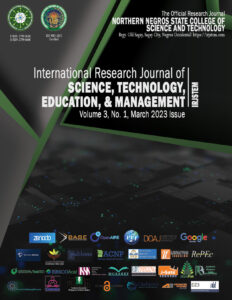March 2023

Suicidal risks and coping strategies of student personnel assistants in a southern Philippine college
Daryl B. Casamorin, Henry E. Lemana II, Sherry V. Mecida, Cathy D. Calong, Angelica S.Padilla, Bria Ysabela O. Santiago, John Lloyd B. Mestidio, Kenn N. Tulod, Michael E. Ganayo III, Paloma B. Ladrido, Ralf Vincent P. Bagual
Notre Dame of Tacurong College, Tacurong City, Sultan Kudarat, Philippines
Full Paper PDF Abstract 1-15
Socio-demographic characteristics and perceived constraints of the farmers to crop production in selected barangays of Cawayan, Masbate, Philippines
Jacob Fredrick P. Velza, Roger Y. Ibañez, Jr., Novy R. Clores, Donata L. Valler
Cawayan Campus, Dr. Emilio B. Espinosa Sr. Memorial State College of Agriculture and Technology, Philippines
Graduate School, Dr. Emilio B. Espinosa Sr. Memorial State College of Agriculture and Technology, Philippines
Full Paper PDF Abstract 16-30
Factors affecting the readiness of digital transformation adopters: A case study in Vietnam
Vinh T. Nguyen, Hue T. Lai, Quynh V. Ha
TNU – University of Information and Communication Technology, Vietnam
Full Paper PDF Abstract 31-42
Level of nationalism and level of heritage conservation of pre-service teachers
Ginuel Janzent Alcantara, Jherwin P. Hermosa
Lutucan Central School, Philippines
Laguna State Polytechnic University, Philippines
Full Paper PDF Abstract 43-54
Basic level English as foreign language teachers’ experience about English medium instruction
Hari Prasad Tiwari
Mahendra Multiple Campus, Nepalgunj Tribhuvan University, Nepal
Full Paper PDF Abstract 55-63
Nursing mothers: Adverse events following immunization and its implication for counselling
Kikelomo O. Adubi, Bolanle M. Oyundoyin, Adijat M. Ariyo, R. A. Adekunbi, Abolanle O. Lasode
Department of Home Science and Management, College of Food Science and Human Ecology Federal University of Agriculture, Abeokuta, Nigeria
Full Paper PDF Abstract 64-77
Gender sensitivity in physical education classes in one state college
Ramonito N. Abesar
Northern Negros State College of Science and Technology
Full Paper PDF Abstract 78-90
The influence of e-commerce adoption on the success of MSMEs in Empat Lawang Regency in the Covid-19 pandemic
Revita Desi Hertin
Faculty of Economy and Business/Jakarta Global University/Indonesia
Full Paper PDF Abstract 91-104
Integrating STEM education: A comprehensive framework for analyzing mathematics classrooms at a primary school
Huey Lei, Tony Li, Janice Ao
University of Saint Joseph, Macao SAR China
Colégio Diocesano de São José, Macao SAR China
Full Paper PDF Abstract 105-116
Professional life quality as correlate to job satisfaction of public elementary teachers: Basis for mental health fatigue solace program
Anthony S. Gonzales, Dennis G. Caballes
Cagmaslog Elementary School, Philippines
National Teachers College, Philippines
Full Paper PDF Abstract 117-133
The development of a disruption responsive smart room technology with attendance management system
Jennifer P. Juaneza
Carlos Hilado Memorial State University-Binalbagan Campus, Philippines
Full Paper PDF Abstract 134-149
